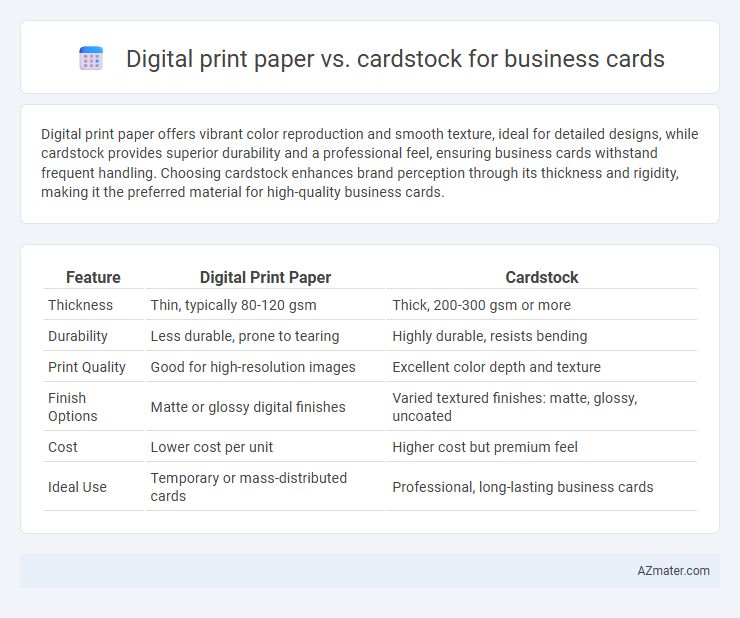Digital print paper offers vibrant color reproduction and smooth texture, ideal for detailed designs, while cardstock provides superior durability and a professional feel, ensuring business cards withstand frequent handling. Choosing cardstock enhances brand perception through its thickness and rigidity, making it the preferred material for high-quality business cards.
Table of Comparison
| Feature | Digital Print Paper | Cardstock |
|---|---|---|
| Thickness | Thin, typically 80-120 gsm | Thick, 200-300 gsm or more |
| Durability | Less durable, prone to tearing | Highly durable, resists bending |
| Print Quality | Good for high-resolution images | Excellent color depth and texture |
| Finish Options | Matte or glossy digital finishes | Varied textured finishes: matte, glossy, uncoated |
| Cost | Lower cost per unit | Higher cost but premium feel |
| Ideal Use | Temporary or mass-distributed cards | Professional, long-lasting business cards |
Understanding Digital Print Paper and Cardstock
Digital print paper for business cards offers a smooth surface ideal for high-resolution images and vibrant colors, making it suitable for detailed and colorful designs. Cardstock, thicker and sturdier, provides durability and a professional tactile experience, enhancing the card's perceived value and longevity. Choosing between digital print paper and cardstock depends on the desired balance between image quality and physical robustness in business card presentation.
Key Differences Between Digital Print Paper and Cardstock
Digital print paper, typically thinner and smoother, offers high-resolution image quality ideal for intricate business card designs but lacks the durability and rigidity of cardstock. Cardstock is thicker, more durable, and provides a premium tactile feel, making it ideal for business cards that require sturdiness and a professional appearance. The key differences lie in weight, texture, and durability, with cardstock generally ranging from 80 to 110 lb cover weight compared to digital print paper's lighter 20 to 80 lb text weight.
Durability: Which Material Lasts Longer?
Cardstock offers superior durability compared to digital print paper, making it the preferred choice for business cards that withstand frequent handling and environmental wear. Its thicker and denser composition resists bending, tearing, and moisture better than the thinner, less robust digital print paper. Choosing high-quality cardstock ensures longevity and professional appearance, essential for making a lasting impression in business networking.
Print Quality: Sharpness and Color Vibrancy
Digital print paper offers moderate sharpness and color vibrancy suitable for everyday business cards but may lack the depth and crispness required for premium presentations. Cardstock enhances print quality with superior sharpness and richer color saturation due to its thicker, textured surface that absorbs ink more effectively. Choosing cardstock ensures vibrant hues and crisp details, delivering a more professional and lasting impression.
Texture and Finish: First Impressions Matter
Digital print paper offers a smooth and glossy finish that enhances vibrant colors, making it ideal for sleek, modern business cards. Cardstock provides a thicker, textured feel that conveys durability and professionalism, often preferred for tactile impact and premium impression. Choosing between the two depends on the desired first impression: glossy digital print signals innovation, while textured cardstock emphasizes quality and reliability.
Suitability for Professional Branding
Digital print paper offers a cost-effective and vibrant solution suitable for short-run business cards with intricate designs and color gradients. Cardstock provides superior durability, a premium feel, and a tactile weight that enhances professional branding, conveying trust and quality to clients. Choosing cardstock is crucial for establishing a memorable and authoritative brand presence in competitive markets.
Cost Comparison: Budgeting for Business Cards
Digital print paper for business cards offers a lower initial cost, making it ideal for small batches and startups aiming to minimize expenses. Cardstock, though more expensive per sheet, provides greater durability and a premium feel that often justifies the higher investment for established businesses. Budgeting decisions should weigh the trade-off between cost efficiency of digital print paper and the long-term value and professional impact of cardstock.
Customization Options: From Coatings to Embossing
Digital print paper offers extensive customization options such as vibrant coatings, including matte, gloss, and soft-touch finishes that enhance visual appeal while maintaining cost efficiency. Cardstock excels in embossing and debossing techniques, providing a tactile dimension and premium feel ideal for luxury business cards. Both materials support foil stamping and spot UV effects, allowing businesses to create highly personalized cards that strengthen brand identity through texture and visual impact.
Environmental Impact: Sustainable Choices
Digital print paper for business cards typically uses thinner, less resource-intensive materials, reducing overall environmental impact compared to cardstock, which requires more raw materials and energy for production. Both options can be sourced from recycled or FSC-certified fibers to enhance sustainability, but paper often offers better recyclability and biodegradability. Choosing digital print paper with eco-friendly inks minimizes carbon footprint, promoting greener business card solutions without sacrificing quality.
Choosing the Right Material for Your Business Cards
Digital print paper offers vibrant color reproduction and affordability, ideal for short runs and intricate designs, while cardstock provides durability and a premium feel, enhancing the tactile impression of your business cards. Selecting the right material depends on your brand image and usage intent, with cardstock often preferred for professional presentations due to its thickness typically ranging from 80 lb to 110 lb cover weight. Consider the balance between print quality, cost, and longevity to ensure your business cards effectively represent your business identity.

Infographic: Digital print paper vs Cardstock for Business card
 azmater.com
azmater.com